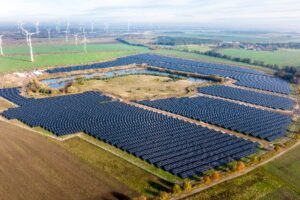Advantages and Disadvantages of Biomethane

Biomethane, a renewable and sustainable energy source, offers several advantages and disadvantages that influence its widespread adoption and use. Understanding these factors is crucial for assessing the role of biomethane in the transition to a more sustainable and environmentally friendly energy landscape. Let’s see in detail, what are the advantages and disadvantages of biomethane.
Advantages of Biomethane
1. Renewable Energy Source
Biomethane is produced from organic materials like agricultural waste, sewage, forest waste and landfill gas. This ensures a continuous and sustainable source of clean energy, making it a key player in the shift away from the dirty fossil fuels.
2. Greenhouse Gas Reduction
Biomethane production significantly reduces methane emissions from organic waste sources. By capturing and utilizing methane, a potent greenhouse gas, biomethane helps mitigate climate change and environmental damage.
3. Energy Independence
Biomethane production can enhance energy security by providing a local, reliable source of energy. This reduces dependence on imported fossil fuels and the vulnerability associated with international energy markets.
4. Versatile Applications
Biomethane can be used in various sectors, including electricity generation, heating, industrial processes, transportation, and more. Its versatility makes it suitable for a wide range of applications.
5. Waste Reduction and Management
Biomethane encourages efficient waste management practices, such as landfill gas recovery and organic waste digestion. It transforms organic waste into a valuable resource while reducing environmental pollution.
6. Reduced Air Pollution
When used as a vehicle fuel or for heating, biomethane produces lower levels of air pollutants compared to traditional fossil fuels. This contributes to improved air quality and public health.
7. Job Creation
Biomethane projects, from feedstock collection to energy production, create employment opportunities, especially in rural areas. This supports local economies and rural development.
8. Biogas-to-Biomethane Upgrading
The upgrading process improves the purity of biomethane, making it suitable for injection into natural gas grids and use in various applications. This technological advancement widens its potential uses.

Biomethane production facility in Europe, image source: Unsplash
9. Carbon-Neutral Potential
Biomethane has the potential to be a carbon-neutral energy source when its production is integrated with carbon capture and storage (CCS) or when carbon offsets are utilized.
10. Grid Injection and Energy Storage
Biomethane can be injected directly into natural gas grids, offering a means of storing excess energy and supplying it during high demand periods. This contributes to grid stability and flexibility.
11. Reduced Dependency on Fossil Fuels
Widespread adoption of biomethane can help reduce reliance on finite fossil fuel resources, promoting a transition to cleaner and more sustainable energy sources.
12. Local Economic Benefits
Biomethane production often occurs in rural areas, providing local economic stimulus, creating jobs, and enhancing the vitality of agricultural and farming communities.
13. Energy Security
Localized biomethane production reduces vulnerability to energy supply disruptions, enhancing energy security for regions and countries.
14. Energy Diversification
Biomethane diversifies the energy mix of the region or country where is used, providing a stable and sustainable energy source that complements intermittent renewables like wind and solar power.
Disadvantages of Biomethane
1. Resource Availability
Biomethane production is dependent on the availability of organic waste materials, which may not be consistent in all regions. This can limit its widespread adoption.
2. Initial Investment Costs
Establishing biomethane production facilities and upgrading infrastructure can involve significant upfront costs, which may deter some potential investors and operators.
3. Methane Leakage
While biomethane production reduces methane emissions from organic waste, there can still be some methane leakage during the production and transportation processes, which contributes to greenhouse gas emissions.

Methane leakage can occur during transportation, image source: Unsplash
4. Energy Density
Biomethane has a lower energy density compared to traditional fossil fuels, which means larger storage and transportation volumes are required to achieve similar energy outputs.
5. Technology and Infrastructure Development
The full realization of biomethane’s potential requires ongoing technological advancements and infrastructure development to ensure efficient production, distribution, and utilization.
6. Regulatory Challenges
Biomethane production and injection into natural gas grids can be subject to complex regulations and standards, which can create barriers to entry for some stakeholders.
7. Competition for Feedstock
In regions with high competition for organic waste feedstock, securing a reliable and sustainable supply can be challenging, potentially limiting biomethane production.
8. Energy Conversion Losses
Biomethane production processes, such as anaerobic digestion or gasification, can involve energy losses, reducing overall energy efficiency.
9. Limited Awareness
In some regions, limited awareness and knowledge about biomethane’s benefits and applications can hinder its adoption and investment.
10. Carbon Intensity
Biomethane production and utilization can vary in terms of carbon intensity, depending on feedstock types, production processes, and the presence of carbon capture and storage (CCS) technologies.
11. Storage and Transportation Challenges
Biomethane’s lower energy density requires efficient storage and transportation solutions, which can be logistically complex and costly.
12. Public Perception
Biomethane may face public acceptance challenges, as some communities may be concerned about the potential odor, safety, or aesthetics of biomethane production facilities.
13. Competition with Food Production
In regions where organic waste is in high demand for agricultural use, there may be competition between using feedstock for food production or biomethane generation.
14. Sustainability Considerations
Biomethane’s environmental benefits depend on sustainable feedstock sourcing and responsible waste management practices to ensure a minimal carbon footprint.
15. Technical Challenges
Biomethane production and storage involve various technical challenges, including process efficiency, biomethane upgrading, and gas grid integration.
16. Feedstock Availability
Biomethane production relies on organic waste materials, and the availability and cost of these feedstocks can vary, impacting the economic feasibility of projects.
17. Production Costs
Biomethane production and purification can be costly, primarily due to the need for specialized equipment and technology. These costs may impact its competitiveness with other energy sources.
18. Maintenance and Operational Requirements
Biomethane production facilities, like any energy infrastructure, require ongoing maintenance and operational oversight, adding to the overall cost of production.
19. Regulatory and Policy Support
The growth of biomethane is often contingent on supportive regulatory frameworks and policies that promote its development and use.
Conclusion
In conclusion, biomethane represents a promising avenue for sustainable and renewable energy, with numerous advantages in reducing greenhouse gas emissions, promoting waste management, and enhancing energy security. However, it also faces challenges related to resource availability, upfront costs, and regulatory complexities. To unlock its full potential, further investment in research, technology, and supportive policies is essential.







